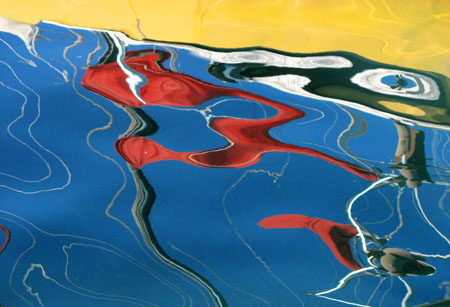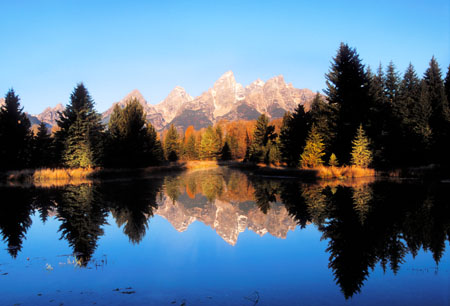 Reflections are most commonly found near water, particularly around sheltered lakes. However, many other smooth surfaces also reveal interesting possibilities. These include the windows of modern office buildings, mirrors and polished surfaces on cars.
Reflections are most commonly found near water, particularly around sheltered lakes. However, many other smooth surfaces also reveal interesting possibilities. These include the windows of modern office buildings, mirrors and polished surfaces on cars.
Reflections in water are utterly dependent upon still conditions, and are consequently very often at their best at dawn. Lakes and ponds may have perfect mirror-like surfaces at this time, but it takes only the slightest breeze to remove the reflections. Landscapes and buildings reflected in still water make wonderful images. The reflected images can be indistinguishable from reality but are usually one or two stops darker. Take exposure readings from both areas and use a graduated neutral density filter to balance exposures when the difference is greater than two stops. Remember to focus on the landscape or building rather than the reflection, and use an aperture to give adequate depth of field if you want the reflection to be sharp.
 Rewarding reflections are not only found in large bodies of water. Humble puddles of water in a street can produce wonderful effects but it is usually necessary to get down low before they become apparent. Including a reflected image of this nature can transform an otherwise ordinary image into something special.
Rewarding reflections are not only found in large bodies of water. Humble puddles of water in a street can produce wonderful effects but it is usually necessary to get down low before they become apparent. Including a reflected image of this nature can transform an otherwise ordinary image into something special.
Reflections in the tinted mirror-like surfaces of modern glass buildings offer quite different possibilities. Uniform grids of glass panels often present a wonderfully disjointed or distorted reflection of adjacent structures. These can be photographed from all sorts of angles to make the most of converging verticals and diagonal lines. Las Vegas offers some of the best opportunities of this type. Unusual and eccentric buildings are designed specifically to reveal interesting reflections and incorporate reflections of other reflections.






